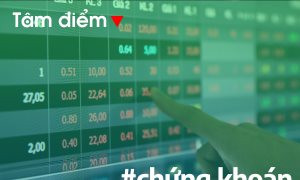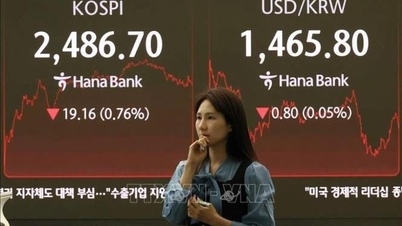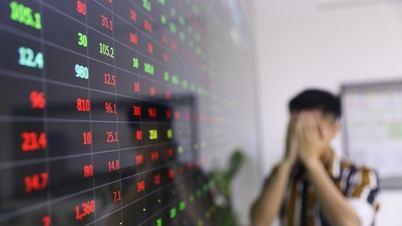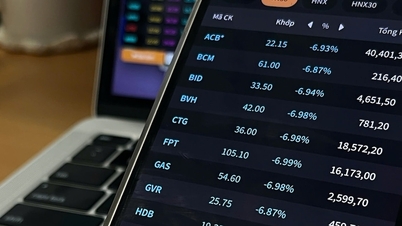
Notably, in May, supporting information will gradually decrease as financial reports, shareholders' meetings, and business plans have all been announced by businesses before and during April.
High selling pressure and cautious cash flow
According to Vietnam Construction Securities Joint Stock Company (CSI), technically, the increase in points last week was not too strong in terms of points, but liquidity decreased sharply (matching volume on HOSE decreased by 18.3% compared to the 20-week average), so there was not enough momentum to confirm a reversal in the increase.
Experts from Saigon - Hanoi Securities Joint Stock Company (SHS) said that in the last session of the week before the long holiday, the VN-Index was under pressure at the beginning of the session due to the information that the State Securities Commission had not yet approved HOSE's proposal to put the KRX system into official operation on May 2, 2024, then recovered strongly to the price range of 1,216 points, corresponding to the lowest price of the session with a strong decrease on April 15, 2024.
At the end of the last trading week of April, VN-Index recovered by 2.95% to 1,209.52 points, remaining in the price range of 1,200 - 1,211 points, corresponding to the highest price in 2018 and below the resistance range of 1,216 - 1,225 points, corresponding to the price range of the previous strong decline sessions. HNX-Index closed the week at 226.82 points, up 2.73% compared to the previous week.
During the week, liquidity on HOSE only reached VND 82,793 billion, down sharply by 36.6% compared to the previous week, this is a liquidity level below average.
The stock market is strongly differentiated, with good recovery concentrated in codes and groups of codes with positive first-quarter business results. Foreign investors continued to net sell with a value of VND 1,128.61 billion on HOSE, while net buying on HNX reached VND 339.49 billion.
The market received a lot of information this week such as: US GDP in the first quarter of 2024 grew by 1.6%, lower than expected, also the lowest growth rate in nearly two years. Inflation remained high when the PCE index (an index measuring the price change of consumer goods and services exchanged in the US economy ) in the first quarter increased by 3.4% compared to the same period last year, higher than the 2% target of the US Federal Reserve (Fed); The State Bank extended the application period of Circular 02/2023/TT-NHNN dated April 23, 2023 regulating credit institutions and foreign bank branches to restructure debt repayment terms and maintain debt groups to support customers in difficulty until the end of 2024; The Bank of Japan (BOJ) decided to keep interest rates unchanged.
In the last trading week of April, the market recovered quite positively in terms of points and the focus was on technology and telecommunications stocks before impressive business results reports for the first quarter of 2024. At the same time, information aboutFPT Corporation's strategic cooperation with NVIDIA - the world's leading multinational technology group helped many stocks increase sharply in price, surpassing the peak and having sudden liquidity such as VGI increased by 29.5%, VTK increased by 19.34%, FOX increased by 13.45%, FPT increased by 13.03%, VTP increased by 10.53%...
The group of seaport stocks also had outstanding developments with GMD increasing by 5.2%, surpassing the peak with strong liquidity increase, other codes also recovered strongly such as HAH increasing by 8.28%, VOS increasing by 7.07%, VSC increasing by 5.41%...
Retail stocks also performed very well following the news of growing business results. Specifically, FRT increased by 14.18%, MWG increased by 13.90%, DGW increased by 10.28%, PET increased by 4.72%...
Meanwhile, stock stocks, after recovering from news of KRX's operation, were under pressure to adjust again in the last session of the week due to the expected delay in operation time.
However, at the end of the trading week, many codes still recovered such as TVB increased by 19.23%, TVS increased by 9.56%, BVS increased by 9.26%, VND increased by 9.26%... Banking codes also recovered quite strongly with VBB increased by 15.62%, EIB increased by 8.79%, TPB increased by 7.83%, HDB increased by 6.07%...
In the short term, having regained the previous support zone of 1,200 points, VN-Index has developed according to the positive scenario of completing the small w model and continuing to recover in the weekend session as SHS predicted.
"Next week, the market is expected to continue its short-term recovery with the near resistance level around 1,225 points and further at 1,250 points, corresponding to the upper edge of the medium-term accumulation zone," said SHS expert.
In fact, historical data shows that the stock market has "plummeted" many times in May. This is not uncommon in stock markets around the world. According to analysts, the reason for the decline in May is due to the lack of information in the market.
Financial reports, shareholders' meetings, and business plans were all announced before and during April, while second quarter business results will not be announced until the end of June or early July.
In addition, there is a holiday in early May, which is also the peak tourist season. People tend to withdraw money from the stock market to serve their personal needs, so the market falls and liquidity also decreases.
In the Vietnamese stock market in April 2022, the VN-Index reached a historic peak of over 1,500 points, then plummeted sharply. Up to now, this index has not been able to recover and is still trying to surpass the 1,300 point mark.
The Vietnamese stock market still has to face unfavorable factors such as foreign investors continuously net selling plus exchange rates and interbank interest rates increasing again.
Experts from VNDirect Securities Joint Stock Company (VNDirect) said that pressure on exchange rates still exists.
As of April 19, the US dollar index (DXY) soared to 106.15, up 2.2% month-on-month, while the USD/VND exchange rate rose to VND25,445, up 2.8% month-on-month and 4.8% year-on-year.
The sharp increase in exchange rates forced the State Bank to intervene. On April 19, the State Bank announced that it had begun selling USD to commercial banks with negative foreign currency positions at a price of VND25,450 (spot sale).
VNDirect estimates Vietnam's current foreign exchange reserves at around $94 billion, equivalent to 3.4 months of imports, slightly higher than the IMF's recommendation of 12-14 weeks of imports.
Therefore, Vietnam has room to sell foreign currency reserves to stabilize the exchange rate, but resources are not abundant.
"Therefore, although DXY may cool down when the Fed signals that it will definitely lower the operating interest rate, the exchange rate is still a notable risk and needs to be closely monitored until the end of the third quarter of 2024," experts from VNDirect recommended.
According to VNDirect, deposit interest rates may have bottomed out, but will not increase sharply again immediately, at least in the next quarter, due to the newly recovered economy and moderate credit growth.
Furthermore, the State Bank has been net injecting money through OMO (a monetary policy tool related to the purchase and sale of securities to control the money supply) in recent trading sessions when credit demand recovered in March to limit the local liquidity shortage in the banking system; maintain interbank interest rates in a reasonable range, avoid overheating; ensure the target of supporting exchange rates and avoid putting too much pressure on increasing deposit and lending interest rates.
Regarding lending interest rates, commercial banks still have room to reduce them further (although not much) thanks to reducing capital costs after the reduction in deposit interest rates from late 2023 to early 2024.
Experts from Nhat Viet Securities Joint Stock Company (VFS) believe that in the context of the correction not being confirmed to have ended, investors should still keep their stock weight at a low level and continue to monitor price movements in the 1,200 - 1,230 point range to assess the possibility of the market bottoming out.
In fact, the Vietnamese market currently does not have much supportive information, in the context of the world stock market's not very positive developments.
Waiting for news from the Fed, US stocks fell sharply
The US stock market closed sharply lower on April 30 as investors awaited important economic data and the US Federal Reserve (Fed) began its two-day policy meeting.
In New York (USA), the Dow Jones industrial index fell 1.49% to 37,815.92 points. The S&P 500 index lost 1.57% to 5,035.68 points, and the Nasdaq Composite technology index fell 2.04% to 15,657.82 points.
On the other side of the Atlantic, European stocks closed lower on April 30 as a series of dismal earnings reports weighed on investor sentiment amid upbeat economic data and growing odds that the European Central Bank (ECB) could cut interest rates in June 2024.
The pan-European STOXX 600 index fell 0.68% and MSCI's gauge of stocks across the globe fell 1.23%. The MSCI Asia Pacific ex-Japan index fell 0.41%, while Japan's Nikkei 225 index rose 1.24%.
The higher-than-expected jobs report triggered the selling, said Jay Hatfield, portfolio manager at InfraCap in New York, adding that investors are preparing for the possibility that the Fed may take a tightening stance at its upcoming meeting.
The Federal Open Market Committee (FMOC), the Fed's policymaking body, has been meeting since April 30 to discuss interest rates, which are expected to remain in the range of 5.25% to 5.50%.
The accompanying statement, as well as Fed Chairman Jerome Powell's subsequent press conference, will be closely analyzed by investors for clues regarding the central bank's expected path toward rate cuts.
The first-quarter 2024 earnings season is halfway through, with some notable names like Amazon.com and Apple Inc set to announce their results this week.
The US dollar regained strength against a basket of world currencies thanks to economic data, while the yen weakened against the greenback, following the Japanese government's alleged currency intervention on April 29.
The dollar index rose 0.62 percent. The Japanese yen fell 0.89 percent against the greenback to 157.75 yen per dollar.
Financial markets in China, Hong Kong Special Administrative Region (China), India, Indonesia, the Philippines, Singapore, South Korea and Thailand are closed for the May 1 International Labor Day holiday.
Meanwhile, in the Tokyo market (Japan), the Nikkei 225 index fell 0.6% to 38,189.54 points due to sparse trading on the May 1 holiday and following a sharp decline in the US stock market./.
TT (According to VNA)Source


![[Photo] Opening of the 13th Conference of the 13th Party Central Committee](https://vphoto.vietnam.vn/thumb/1200x675/vietnam/resource/IMAGE/2025/10/6/d4b269e6c4b64696af775925cb608560)





























![[Photo] Prime Minister Pham Minh Chinh chairs the Government's online conference with localities](https://vphoto.vietnam.vn/thumb/1200x675/vietnam/resource/IMAGE/2025/10/5/264793cfb4404c63a701d235ff43e1bd)





































































Comment (0)